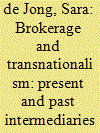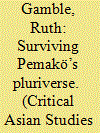| Srl | Item |
| 1 |
ID:
161134


|
|
|
|
|
| Summary/Abstract |
This article brings two distinct sets of literatures in dialogue with one another: ethnohistorical studies on cultural brokerage and mediation in colonial/settler societies and studies of contemporary transnational activities. The article argues that this is productive because it throws into sharper relief three significant areas of contention that are a common thread of many empirical transnational studies, but are rarely of central concern. For each of these three identified aspects, respectively, the desire for mediation, social mobility, and mixed loyalties, it traces the historical resonance with cultural brokerage and shows how ethnohistorical research can complicate current transnational studies. It thereby challenges transnational scholarship’s focus on the newness of transnational exchange and demonstrates how ethnohistorical findings on brokers and mediators can aid the development of the research agenda of transnational studies.
|
|
|
|
|
|
|
|
|
|
|
|
|
|
|
|
| 2 |
ID:
188577


|
|
|
|
|
| Summary/Abstract |
This article traces a multi-generation history of Kunga Tsomo’s family, from the early 1900s when her grandmother migrated to Pemakö in the eastern Himalaya until the twenty-first century. Grandmother’s journey to Pemakö was part of a larger Vajrayana Buddhist migration to “hidden lands” in the southern Himalaya. This movement is most often framed as a religious event, but also involved the dispossession of Indigenous peoples, including the Adi of southern Pemakö. After coming to a negotiated settlement over land, the newly arrived Vajrayana Buddhists and Adi lived in neighboring villages within different ontologies. But soon after this settlement, a series of external states and institutions colonized Pemakö. The British and Qing Empires sent military expeditions in the 1910s. In the 1930s, the Tibetans annexed the territory. In the 1950s, it was bifurcated by the Sino-Indian border dispute. In the twenty-first century, it has become a site of a contest between international conservation campaigns and Chinese and Indian hydropower extraction. Despite the transformative effects of these external powers, this is not a story of cultural erasure. The article shows how the family’s commitment to Pemakö, its land and its multiple cultures has helped them survive and thrive.
|
|
|
|
|
|
|
|
|
|
|
|
|
|
|
|